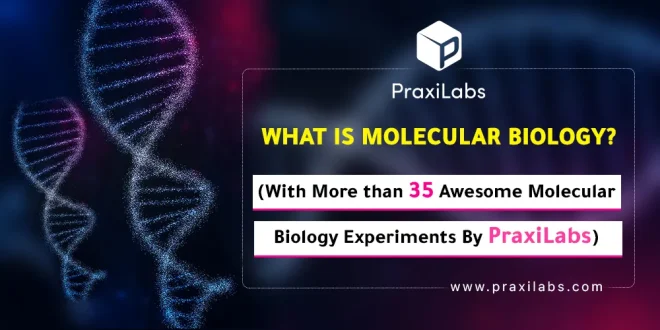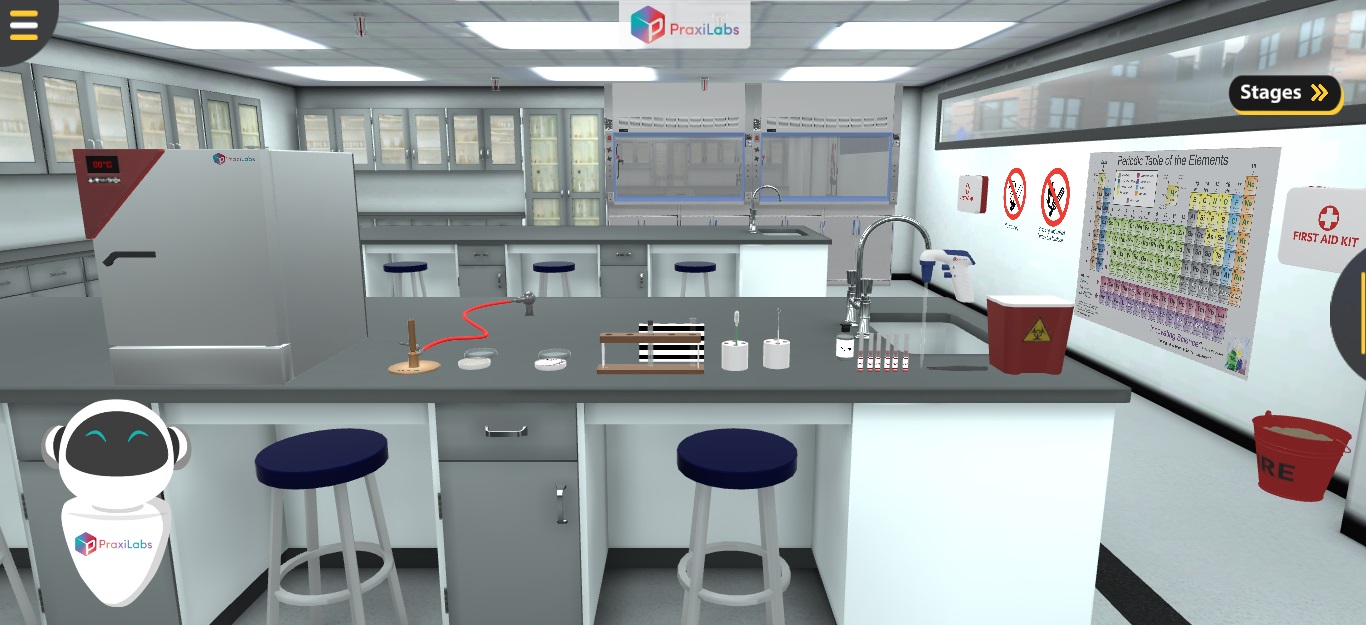Last Updated on August 22, 2025 by Muhamed Elmesery
Molecular biology of the cell involves different macromolecules or biomolecules like proteins, carbohydrates, lipids, DNA and RNA (nucleic acids) and amino acids. Molecular biology studies their chemical and physical structures, compositions, modification, mechanisms, interactions, and functions which are essential and vital to life processes.
In this article, you will learn more about what is molecular biology, its techniques, how does it provide evidence for evolution, what is molecular biology central dogma? and a list of more than 35 molecular biology virtual lab experiments introduced by PraxiLabs.
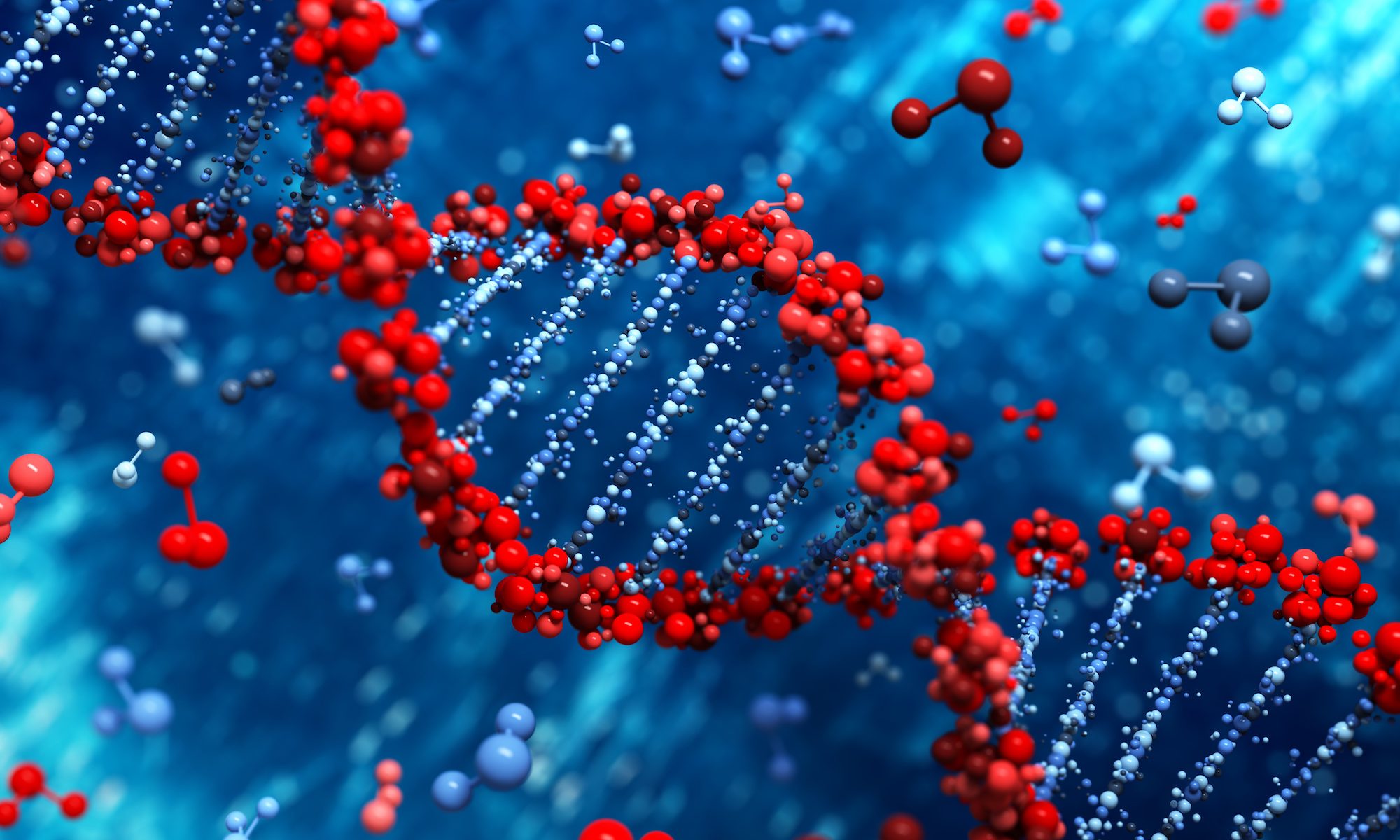
Table of Contents
What is Molecular Biology?
In simple words, molecular biology definition is the branch of science that is interested in studying various biological activities at the molecular level (between or in the cells).
To know what is molecular biology? Let’s take an overview at the science of molecular biology.
History of Molecular Biology
The origin of molecular biology began in the 1930s with the convergence of various, previously distinct branches of biological and physical science, such as microbiology, biochemistry, genetics, physics, and more. Because of the desire to understand life at its most fundamental level, several scientists in chemistry and physics also took an interest in what would become molecular biology. In its modern sense, molecular biology attempts to explain the phenomena of life starting from the macromolecular properties that generate them.
Two categories of macromolecules in particular are the focus of the molecular biologists:
- nucleic acids, among which the most famous is deoxyribonucleic acid (or DNA), the constituent of genes.
- proteins, which are the active agents of living organisms.
One definition of the scope of molecular biology therefore, is to characterize the structure, function and relationships between these two types of macromolecules. This relatively limited definition will suffice to allow us to establish a date for the so-called “molecular revolution”, or at least to establish a chronology of its most fundamental developments.
In 1945, the term molecular biology was used by the physicist William Astbury. In 1953, Francis Crick, James Watson, Rosalind Franklin, and colleagues, working at the Medical Research Council unit, Cavendish laboratory, Cambridge (now the MRC Laboratory of Molecular Biology), made a double helix model of DNA which changed the entire research scenario. They proposed the DNA structure based on previous research done by Rosalind Franklin and Maurice Wilkins. This research then led to finding DNA material in other microorganisms, plants and animals.
What is the Central Dogma of Molecular Biology?
The central dogma of molecular biology is a theory that explains that the flow of genetic information (from DNA to RNA to protein) occurs only in one direction to make a functional product. The central dogma of molecular cell biology says that our DNA contains the needed information to make all of our proteins, and the role of RNA is a messenger that carries this information to the ribosomes. The role of these ribosomes is that they act as cell factories where the process of information translation from a code into the functional (final) product happens.
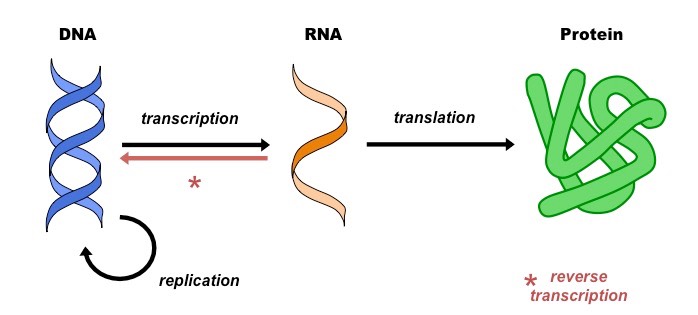
The process of gene expression has 2 stages that are called transcription and translation. In the transcription stage, the information which is found in the DNA of the cell is converted into messages that are portable and small. However in translation, the messages travel or translate from where the DNA is in the cell nucleus to the ribosomes to make specific proteins.
The central dogma of molecular biology states that the pattern of information that occurs in our cells is:
- DNA replication: From existing DNA to make new DNA.
- Transcription: From DNA to make new RNA.
- Translation: From RNA to make new proteins.
PraxiLabs, the 3D virtual lab solution, provides students with access to realistic biology, chemistry, and physics labs and enriches their understanding with a variety of informational and educational content.
Pick the Best Virtual Plan For You
Information about Gene
- Genes are the basic physical and functional units of heredity, and they are segments of DNA.
- Each gene contains information about a certain trait, Our genes carry information that is passed from one generation to the next.
- Genes are transcribed and translated by the cell to make proteins.
- Proteins create a visible phenotype.
Example:
One gene might code for eye color. The gene is used by cells to make proteins that create green pigment in our eyes
Molecular Biology Techniques
Molecular biology techniques are the methods used in molecular biology and other related branches like genetics, biochemistry and biophysics which generally involve processes like modification, interaction, manipulation and analysis of DNA , protein, RNA and lipid.
Let’s put a spotlight on some of the most common molecular biology techniques:
Polymerase Chain Reaction (PCR)
Polymerase chain reaction or PCR is one of the most important methods in molecular biology. It is basically a test tube system for DNA replication that is used to copy DNA and allows a target DNA sequence (single) to be amplified into millions of DNA molecules folds in just a few hours. PCR can also be used to introduce and detect mutations within the DNA or the sites of special restriction enzymes. PCR is also used to detect whether a certain DNA fragment exists in a cDNA library.
In addition, PCR is used widely in the medical and biological fields for a variety of applications such as DNA cloning for sequencing, functional gene analysis, and the diagnosis and detection of hereditary and infectious diseases.
There are many different types of PCR like:
- Real-time PCR.
- Nested PCR.
- Multiplex PCR.
- Quantitative PCR.
- Long-range PCR.
- Hot start PCR.
- Arbitrary Primed PCR.
- Single-cell PCR.
- Methylation-specific PCR (MSP).
- Fast-cycling PCR.
Gel Electrophoresis
Gel electrophoresis is an important molecular biology method used to separate mixtures of DNA, RNA, and proteins depending on their molecular size. In this technique, the molecules to be separated are run by an electric field through agarose gel that contains small pores and that allows you to differentiate between DNA fragments of different lengths.
There are many applications of gel electrophoresis like:
- Crime scenes investigation by separating DNA fragments for DNA fingerprinting.
- Polymerase chain reaction (PCR) results analysis.
- In taxonomy studies, for distinguishing different species by DNA profiling.
- Gene analysis (genes that are associated with a particular illness).
DNA Cloning
DNA cloning is a molecular biology technique that is used to make several identical copies of a piece of DNA, such as a gene or other DNA pieces. DNA cloning is done by inserting a target gene into a circular piece of DNA which is called “plasmid”. Then, through the transformation process, the plasmid is introduced into bacteria (selected by using antibiotics). These bacteria are used to make more plasmid DNA or, induced to express the gene and make protein.
The cloned DNA can be used to:
- Detect and identify the function of the gene.
- Investigate the characteristics of the gene like size, expression, and tissue distribution.
- Make big protein concentrations that are coded by the gene.
- Learn how mutations can affect the function of a gene.
Cell culture
Cell culture is one of the most important molecular cell biology techniques as it provides a platform to investigate the biology, physiology (e.g., aging), biochemistry, and cells and diseased cells metabolism. It is also used to study mutagenesis, carcinogenesis, the effects of drugs and toxic compounds on the cells, and the route of infection and interaction between wild-type cells and pathogenic agents (e.g., fungi, bacteria and viruses).
Cell culture is the process by which human, animal, or plant cells are removed and grown in an artificial environment under controlled condition. For example, cultured animal cells are used in the production of viruses, and these viruses are used to produce vaccines. For example, vaccines for diseases like rabies, chicken pox, polio, measles and hepatitis B are produced using culture of animal cell.
DNA Extraction
We can define DNA extraction as the technique that is used to isolate DNA by breaking the cell and nuclear membrane with the help of some chemical substances or enzymes or physical disruptions. DNA extraction has been the target of a lot of research, as it has many applications like genetic modification of plants, detecting bacteria, and viruses in the environment, altering animals, medical diagnosis, paternity tests, identity verification, pharmaceutical products, and hormone production.
The extraction of DNA is critical to molecular cell biology and biotechnology. It is considered the first step of different applications, varying from routine diagnostic and therapeutic decision-making to fundamental research. The importance of DNA extraction and purification is that they are vital and essential for defining the unique characteristics of DNA, such as its shape, size, and function.
Investigation of the DNA sequence and structure that are related to diseases helped in finding out the molecular basis and cure for various diseases. DNA extraction also allowed the scientists to produce many vaccines, enzymes, and hormones. As well as it was also very beneficial and important in the forensic/medico legal entities.
To study DNA, it must be extracted out of the cell. Hence, DNA extraction technique is widely used in research labs.
With PraxiLabs’ molecular virtual biology lab, students can practice the same experiment for an unlimited number of times, with 100% supervision & 0% risk!
Latest Molecular Biology Studies | Advances in CRISPR Technology
CRISPR (clustered regularly interspaced short palindromic repeats) is a technology that researchers use to selectively modify the DNA of living organisms.
The CRISPR renaissance was catalyzed by the discovery that RNA-guided prokaryotic CRISPR-associated (Cas) proteins can create targeted double-strand breaks in mammalian genomes. This finding led to the development of CRISPR systems that harness natural DNA repair mechanisms to repair deficient genes more easily and precisely than ever before.
CRISPR has been used to knock out harmful mutant genes and to fix errors in coding sequences to rescue disease phenotypes in preclinical studies and in several clinical trials.
However, most genetic disorders result from combinations of mutations, deletions, and duplications in the coding and non-coding regions of the genome and therefore require sophisticated genome engineering strategies beyond a simple gene knockout.
To overcome this limitation, the toolbox of natural and engineered CRISPR–Cas systems has been dramatically expanded to include diverse tools that function in human cells for precise genome editing and epigenome engineering. The application of CRISPR technology to edit the non-coding genome, modulate gene regulation, make precise genetic changes ,and target infectious diseases has the potential to lead to curative therapies for many previously untreatable diseases.
A study proves that the ease with which CRISPR can create targeted DSBs in the human genome , which enabled quick adoption as a broad tool to overcome genetic disorders. As a first step, CRISPR was used to perform targeted gene knockouts, as Cas9 can be targeted anywhere on the coding sequence to induce a frameshift mutation to silence a deleterious protein.
However, most diseases are complex and cannot be cured by this simple coding sequence-targeting strategy. The use of CRISPR to target diseases with complex drivers has been catalyzed by developing more nuanced strategies that target the non-coding genome and indirectly modify gene expression (for example, by exon skipping or intron corrections).
Beyond these approaches, the rapid discovery of natural CRISPR molecules with beneficial properties and further engineering of these proteins to create molecules that alter transcription, change the epigenome, make precise mutations or enable writing directly onto the genome have dramatically increased the range of indications that can potentially be treated using CRISPR–Cas systems. However, further advances are needed to fully leverage these proteins.
The use of CRISPR tools to target more nuanced disease drivers requires a better understanding of how non-coding DNA and epigenetic states affect disease pathology.
Point mutations in coding sequences are much easier to link to a disease phenotype than mutations in non-coding sequences owing to a deep understanding of how a genetic change results in an amino acid change by looking at sequencing information. Using the right CRISPR tool that can link sequence, epigenome, transcriptome and phenotype information to the root cause of a pathology that is not driven by simple polymorphisms, it will be helpful in defining new cures.
However, the rapid advances in CRISPR tools, multi-omic methods and delivery mechanisms indicate that genome engineering techniques will soon be developed for a multitude of diseases, potentially resulting in curative therapies for many underserved patient populations.
Study: Advances in CRISPR therapeutics | Nature
Molecular Biology Demystified: Your Top FAQs Answered
What is the basis of molecular biology?
The basics of molecular biology mainly focus on understanding the interactions between the various components of a cell, including the interactions between DNA (deoxyribonucleic acid), RNA (Ribonucleic acid) and protein biosynthesis as well as learning how these interactions occur and are regulated.
What is an interesting fact about molecular biology?
Scientists did not know DNA contained genes until 1943. Prior to that, they believed that genes were stored in proteins.
If all the DNA stored within your body was placed side by side in a chain, it would be 600 times longer than the distance from the Earth to the Sun and back.
Human DNA is 98% identical to that of a chimpanzee, while it is 40-50% identical to that of a cabbage.
If you could write 60 words per minute, and you continued to work 8 hours a day, it would take 50 years to write the human genome.
What does molecular biology look at?
The field of molecular biology looks at macromolecules found in living things and their chemical and physical structures, compositions, modifications, mechanisms, interactions, and functions which are essential and vital to life processes.
What are the basic principles of molecular biology?
DNA extraction, DNA replication, gene expression, protein synthesis, DNA sequencing,the central dogma, transcription, cloning, and more.
What are common molecular biology techniques?
Molecular biology techniques are the methods used in molecular biology and other related branches which generally involve processes like modification, interaction, manipulation and analysis of DNA , proteins, RNA and lipids.
Here are some of the most common molecular biology techniques:
- Polymerase Chain Reaction (PCR).
- DNA cloning.
- Western blot.
- Gel electrophoresis.
- DNA extraction.
- Centrifugation.
- Cell Enzyme-Linked Immunosorbent Assay (ELISA) culture.
What is the central dogma of molecular biology?
The central dogma of molecular biology is a theory stating that genetic information flows only in one direction, from DNA, to RNA, to protein, or RNA directly to protein.
What is the classical period of molecular biology?
Molecular biology’s classical period began in 1953, with James Watson and Francis Crick’s discovery of the double helical structure of DNA (Watson and Crick 1953a,b). Watson and Crick’s scientific relationship unified the various disciplinary approaches discussed above:
- Watson, a student of Luria and the phage group, recognized the need to utilize crystallography to elucidate the structure of DNA.
- Crick, a physicist enticed by Schrödinger’s. What is Life? to turn to biology, became trained in, and contributed to the theory of X-ray crystallography. At Cambridge University, Watson and Crick found that they shared an interest in genes and the structure of DNA.
What is Molecular Biology of Cell Determination?
This series was established to create comprehensive treatises on specific topics in developmental biology. Such volumes serve a useful role in developmental biology, which is a very diverse field that receives contributions from a wide variety of disciplines. This series is a meeting ground for the various practitioners of this science, facilitating an integration of heterogeneous information on specific topics. Each volume comprises chapters selected to provide the conceptual basis for a comprehensive understanding of its topic as well as an analysis of the key experiments upon which that understanding is based.
The specialist in any aspect of developmental biology should understand the experimental background of the specialty and be able to place that body of information in context, in order to ascertain where additional research would be fruitful. The creative process then generates new experiments. This series is intended to be a vital link in that ongoing process of learning and discovery.
How does Molecular Biology Provide Evidence for Evolution?
According to evolution theory, evolution refers to the alteration in a species’ traits over a big number of generations and depends on a method called “the natural selection”. The theory said that “All species are related to one another and change over time”.
The science of molecular biology provides data that supports the evolution theory. In particular, the DNA universality and the genetic code near universality for proteins show that all the living organisms once shared a common ancestor. DNA also provides clues and data about how evolution may have happened. The process of gene duplications allows one copy to undergo mutational events without harming an organism, as one copy continues to produce functional protein.
DNA sequences have also shed light on some of mechanism of Molecular biology and evolution . In general, the similarity of DNA sequence between groups of organisms shows their relatedness.
What’s “Nature Structural & Molecular Biology”?
Nature Structural & Molecular Biology is a monthly peer-reviewed scientific journal publishing research articles, reviews, news, and commentaries in structural and molecular biology, with an emphasis on papers that show “functional and mechanistic”understanding of how molecular components in a biological process work together”.
It is published by the Nature Portfolio and was established in 1994 under the title Nature Structural Biology. Later, it obtained its current title in January 2004. Like other Nature journals, there is no external editorial board, with editorial decisions being made by an in-house team, although peer reviewing by external expert referees forms a part of the review process.
According to the Journal Citation Reports, the journal had a 2020 impact factor of 15.369, ranking it the 13th out of 298 journals in the category “Biochemistry & Molecular Biology”, the 1st out of 72 journals in the category “Biophysics”, and the 16th out of 195 journals in the category “Cell Biology”.
So, if you are interested in Molecular biology news and articles, you can follow the Nature Structural & Molecular Biology journal.
More than 35 Molecular Biology Experiments by PraxiLabs
PraxiLabs provides a vast and exceptionally diverse collection of important molecular biology experiments with awesome features to improve students’ learning experience and outcomes.
Let’s take a look at some of PraxiLabs molecular biology virtual labs simulations!
DNA Extraction
The DNA extraction virtual lab from PraxiLabs lets students practice basic laboratory techniques and understand the protocol and principle involved in DNA extraction well. Students also will identify the role of reagents, techniques and equipment in the extraction of DNA. They will also know more about the importance and applications of DNA extraction.

Conventional PCR
After conducting the conventional PCR virtual experiment, students can demonstrate proficiency with the principle and protocol involved in PCR technique. They conclude downstream applications of conventional PCR.
Agarose Gel Electrophoresis
In agarose gel electrophoresis simulation, students will learn how to identify and separate DNA or RNA molecules by size, the process of separation achieved by placing the molecules in a gel made up of small pores and setting an electric field across the gel. They will learn how to prepare an agarose gel properly, understand and visualize the precautions required during sample application in the gel. Students also will identify the role of reagents, techniques and equipment in the agarose gel electrophoresis experiments.
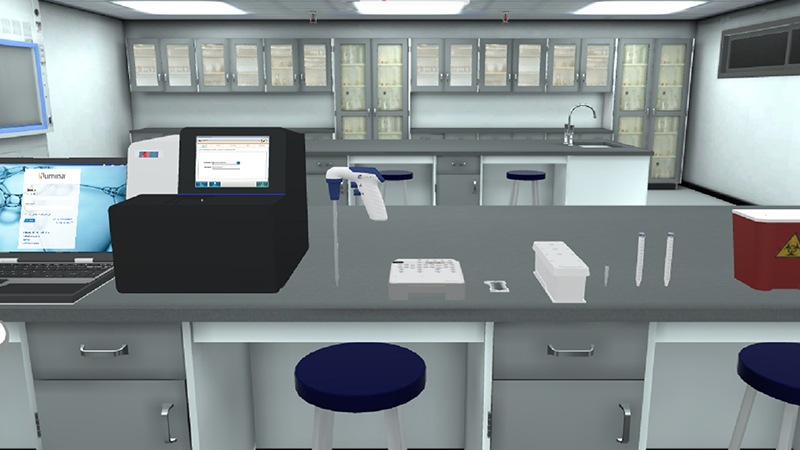
DNA Sequencing
In DNA sequencing virtual lab, students will understand and learn:
- How to apply a DNA sample purification using exosap IT..
- Also how to apply library preparation step by step.
- How to apply DNA fragmentation, amplification and, clean up of fragmented DNA and adapter ligation.
- How to practice library normalization, dilution and denaturation.
- How to perform the protocol of AMPure beads for DNA libraries purification.
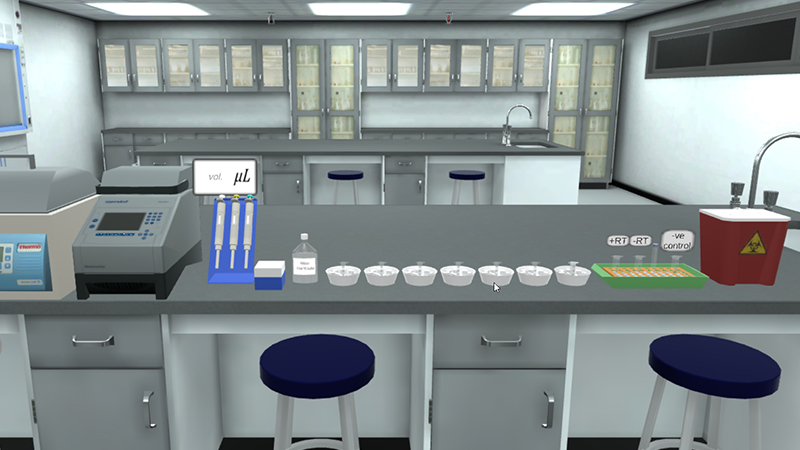
cDNA Synthesis
In cDNA synthesis virtual lab, students will learn how to synthesize cDNA from RNA templates using the enzyme of reverse transcriptase.
By the end of the experiment, students will be able to understand the cDNA Synthesis protocol well which is one of the important Concepts in Molecular Biology, practice the basic laboratory techniques proficiency, and identify the role of specific equipment and reagents that are used in cDNA Synthesis.
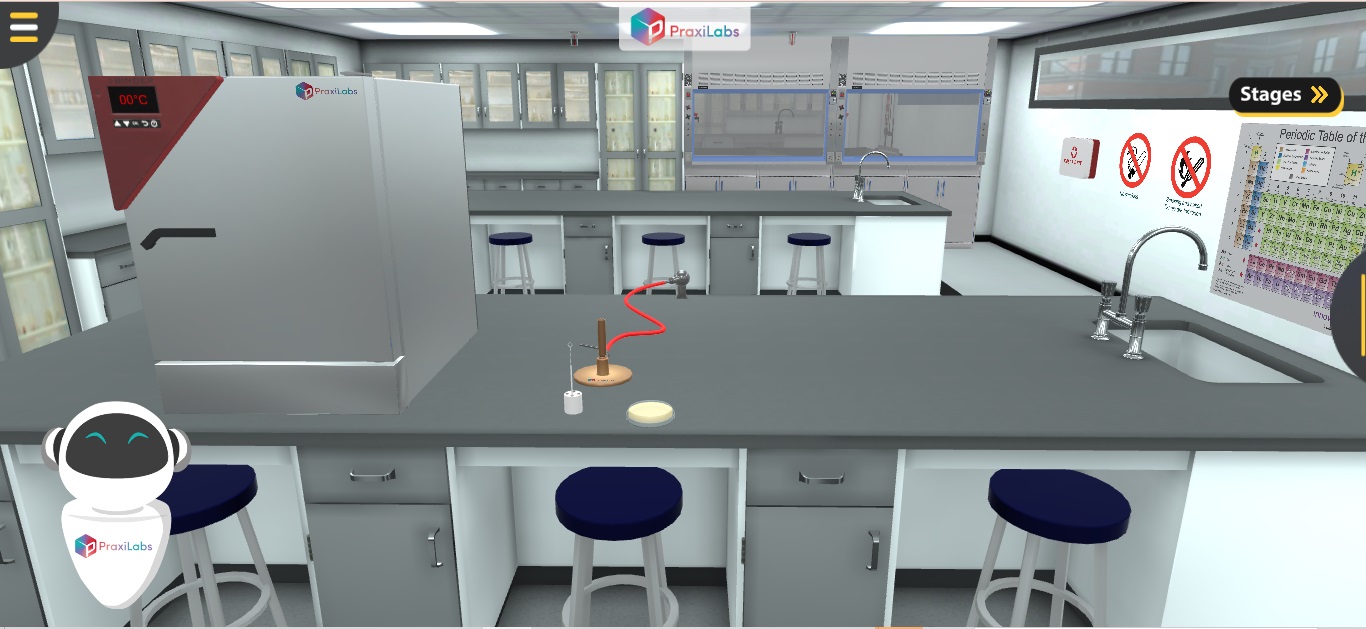
Bacterial Plating out Technique (Streak Plate Method)
In the plating out technique experiment (streak plate method) virtual lab, students will learn how to isolate bacteria from a mixed population into a pure culture of the organisms by streak plate method. They also will become proficient at doing streak plate method accurately and consistently, produce isolated organism colonies on an agar plate, and learn organism identification by performing biochemical tests to identify bacteria (organism) that are only valid when performed on pure cultures.
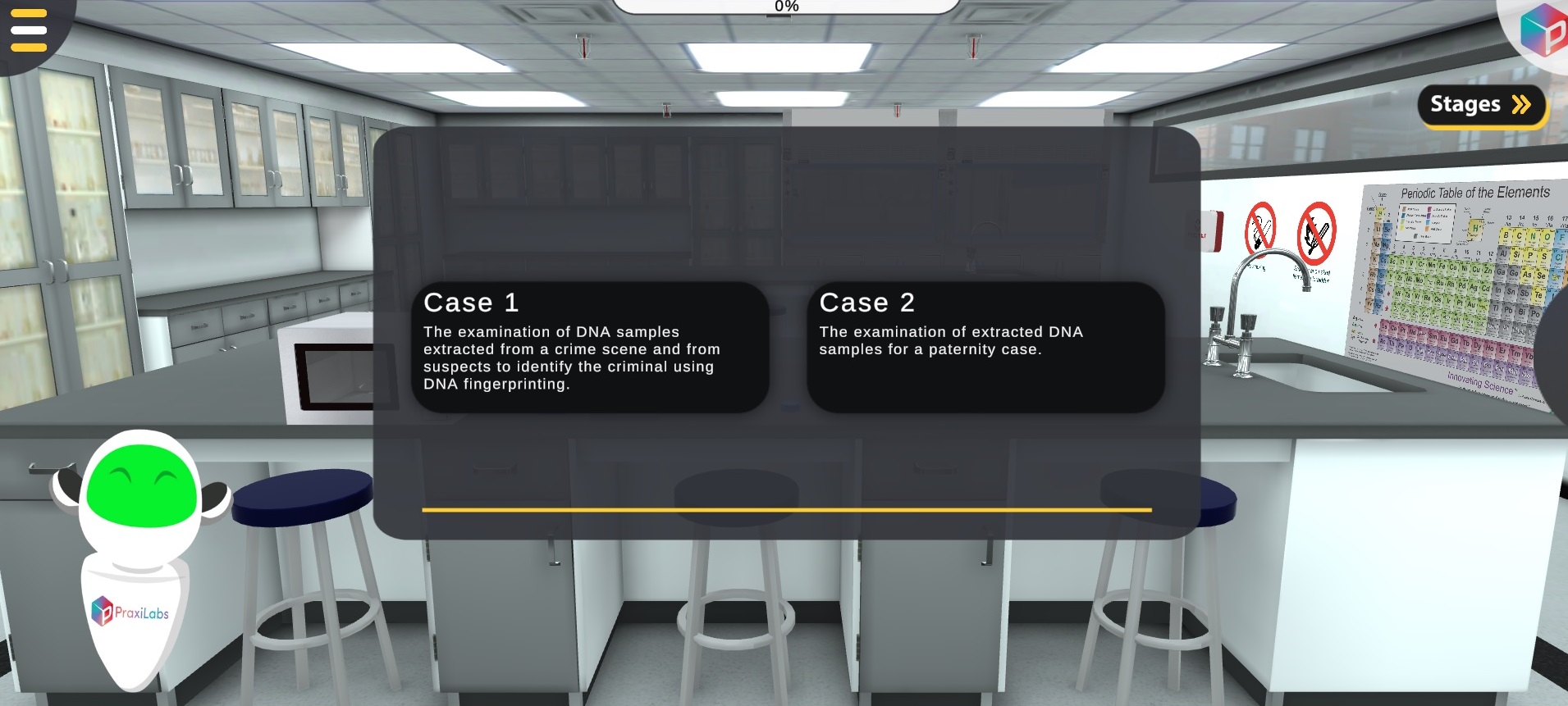
DNA Fingerprinting Using Gel Electrophoresis
By the end of DNA fingerprinting using gel electrophoresis simulation, students will be able to:
- Mention and list the preparation of an optimum agarose gel steps accurately.
- Understand the value and role of chemicals and reagents that are used in the experiment.
- Study the factors which lead to successful sample uploading into the gel Visualize DNA fragments.
- Identify and detect DNA molecules that have been processed by methods such as enzymatic digestion and PCR.
- Identify the restriction sites characteristics that are found in a DNA sequence.
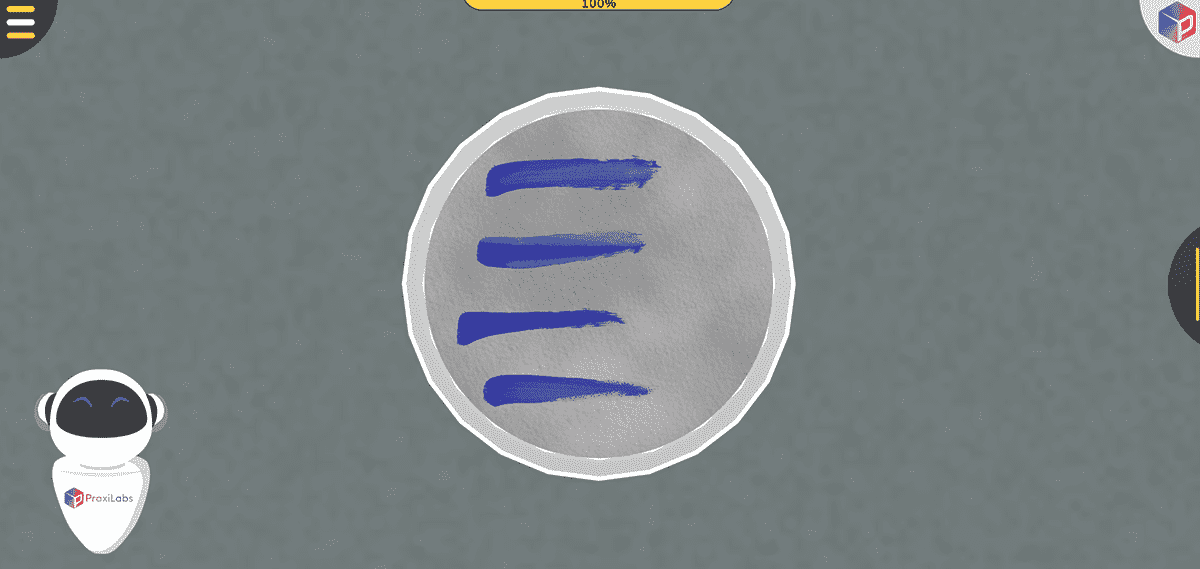
Oxidase Test
In the oxidase test virtual lab, students will learn how to detect if an organism possesses the cytochrome oxidase enzyme. By conducting this test they will be able to differentiate between oxidase positive species like Moraxella, Neisseria, Campylobacter, Pasteurella, and pseudomonads species.
Antibiotic Sensitivity Test Disc Diffusion Method
In antibiotic sensitivity test disc diffusion method simulation, the students will learn how to determine the susceptibility of a microbial species against different antibiotic agents, to utilize specific monitoring techniques to evaluate the susceptibility of a microbe to different antibiotics species, and to detect the range of antibiotic activity.
Real Time PCR
By the end of Real- Time PCR simulation, students will be able to:
- Identify the steps required to accomplish a successful RT-PCR experiment.
- Gain hands-on experience with an RT-PCR protocol.
DNA Microarray
In DNA microarray simulation, students will learn how to:
- Perform the DNA microarray steps.
- Practice the laboratory protocols to synthesize cDNA, cRNA and fragment cRNA prior to hybridization.
- Practice the technique for dual -labeling of samples for microarray hybridization.
- Apply the skills and precautions required for microarray slide handling and sample application.
- Identify the benefits of a positive displacement pipette.
- Practice the process of microarray slide washing prior to detection.
Flow Cytometry Cell Cycle
Learn how to practice the steps of cell fixation and permeabilization, and understand the concept of cell cycle analysis using propidium iodide in the flow cytometry cell cycle virtual lab.
XTT Viability Assay
By the end of XTT viability assay, students will be able to:
- Successfully handle the required instruments and consumables needed for the experiment.
- Check the confluence and count cells under the microscope.
- Dilute the cells to a specific count suitable for seeding into the 96-well plate.
- Calculate the concentration of the tested chemicals and prepare the calculated doses in the cell culture medium.
- Aspirate the old medium and add the new medium containing the tested chemicals into the appropriate wells.
- Add the XTT solution to the cells and read the XTT viability assay results using the microplate reader after the incubation of the cells.
- Read the XTT viability assay experiment results and perform the XTT viability assay calculation: calculate the viability percentage of cells exposed to different doses of tested chemical(s). Understand the xtt viability assay procedure.
Gram Stain Experiment
By the end of the experiment, students will be able to:
- Become proficient at performing the Gram stain consistently and accurately.
- Differentiate between various shapes, sizes, arrangements, and Gram reactions of bacteria.
- To differentiate between the two major categories of bacteria: Gram positive and Gram negative.
- To understand how the Gram stain reaction affects Gram- positive and Gram -negative bacteria based on the biochemical and structural differences of their cell walls.
Haemagglutination Tests
Be proficient at performing Haemagglutination tests procedure consistently and accurately, and learn the essential concepts of hematological tests.
DNA Isolation Experiment
By the end of the experiment, students will be able to :
- Apply the steps of DNA extraction from a culture of Saccharomyces Cerevisiae.
- execute proper restriction enzyme digestion of DNA.
- understand the role of the devices, the reagents and the enzymes used in the process of DNA extraction.
- implement proper storage of samples.
- understand the role of the devices, the reagents and the enzymes used in the process of DNA extraction.
- implement proper storage of samples. To understand restriction digestion of DNA protocol and principle.
Check our Biology Portfolio and Explore More than 35 Virtual Molecular Biology Experiments to Enhance your Students’ Learning Experience and Outcomes!
 PraxiLabs A virtual world of science
PraxiLabs A virtual world of science

